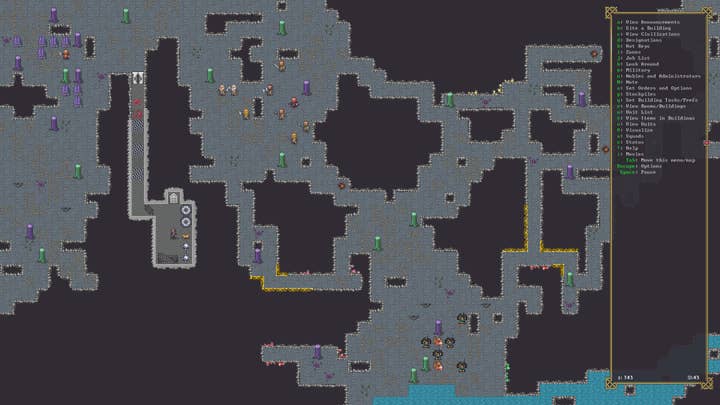What we can learn from... Warframe
From a slow start, Digital Extremes built a service game to rival Destiny, defying every convention along the way
This is the first in a series of articles examining what the industry can learn from single topics, such as games, research and trends.
Warframe is a cult loot shooter that is simultaneously remarkable for what it's achieved and unremarkable in embodying many trends of recent years. Digital Extremes' game is symphonically AAA and lean, PC and free-to-play, bewilderingly complex and immensely popular. It simply does not conform to norms, yet manages to be beautifully playable and endlessly fascinating.
Launched by Unreal co-creators Digital Extremes in 2013 -- as the Canadian studio's last ditch attempt to save itself -- Warframe was met with a mediocre reception. Over the last six years, however, it has grown quietly, layering features while porting to PlayStation 4, Xbox One and, most recently, Nintendo Switch.
According to estimates provided by SuperData, Warframe's revenue has grown an average of 27% year-on-year, reaching $182.5 million in digital revenue across 2018 -- a figure that is comparable to the significantly higher profile Destiny 2, which has an estimated $300 million in digital revenue for 2019.
Warframe's slow, silent growth, with no release fanfare, allowed it to slip by so many of us. This stealth success means we may have missed the important lessons we can gain from such a unique game.
1. Run the marathon

Digital Extremes embraced lean principles for Warframe, with lead designer Scott McGregor calling the initial release "the smallest thing we could get out." GameSpot gave it a disappointing score of six out of ten at launch, but following years of constant improvement the review team recently upped the verdict to an eight. This rescoring draws attention to ostensibly the most notable lessons from Warframe; developing service games is a long grind of constant improvement. At least, it is for those that are successful.
In fact, much of Warframe's success can be traced not only to the quality of its releases, but also the speed and frequency. New content and new gameplay has kept players coming back (and spending) for over half a decade already. This makes good business sense too, as keeping existing players is much more cost effective than acquiring new ones.
But light launching also gave Digital Extremes insight into the wants and needs of its players, letting the team build only features that are both wanted and needed, avoiding costly and unnecessary development. This player-developer integration also builds a grassroots community with a sense of involvement and ownership over the product, which for Warframe has granted life-giving virality.
2. Grow your community to grow your game
"We wanted to be in the thick of it in alpha... We wanted to see where the problems were... It had us glued to the forums" -- Rebbeca Ford, live ops and community director.
Digital Extremes' symbiotic relationship with its player base has been present from early in Warframe's life, with the team fostering discussion with players through forums, streamed Q&A and via email. This close bond resulted in one of Warframe's most iconic features: The parkour-like movement. Players had found an exploit that broke jumping and allowed a player's Tenno (their avatar) to ping great distances across the map. This movement became popular, but was open to abuse and needed patching.
"Warframe simply does not conform to norms, yet manages to be beautifully playable and endlessly fascinating"
Rather than simply patch the exploit, the Warframe team listened to players and decided to bring a more controlled implementation of the movement into the game. It revolutionised the way playing Warframe felt, but it also made the community feel heard. During this same period, Digital Extremes was experiencing difficulty getting coverage from a PC gaming press reluctant to cover free-to-play games, but goodwill from the community spilled over to YouTube, where influencers began talking up the title.
This early YouTube buzz created a viral impact that has been the backbone of Warframe's ongoing growth. Simply put, nurturing a community that supports your work and feels involved in your game will result in evangelism and influencer endorsement that feels genuine. Therefore, hiring experienced community professionals and orienting development to be influenced by community feedback is a worthwhile investment with big upsides.
3. Leverage procedural content
Warframe's early development featured a skeleton staff that understood the need to maintain a service game with lots of content. The team made a smart decision: build levels procedurally. Each mission inside the game is randomly generated from a tile-set, with each set depicting an environment and supporting unique features. This approach gives greater replayability depth, as the same mission can feel different each playthrough. It allows for mechanics that encourage players to revisit content without it feeling like mindless grind.
When designed well, "proc gen" can let small teams build games that feel vast. It can also allow for emergent gameplay as unintended mechanics bump up against each other, resulting in unexpected scenarios. The king of this approach is Dwarf Fortress, a title that creates epic gameplay scenarios despite a development team of two.
Even as Warframe gained traction and the dev team grew into the hundreds, procedural approaches were maintained. Dynamic difficulty scaling and balancing approaches are used liberally, highlighting Digital Extremes' continued adherence to lean principles even at vast team sizes.

4. Don't shy away from complexity
"People are smart... They look at Warframe, they see that complexity, and they smell that the game will require mental energy" -- Steve Sinclair, game director
Another similarity to Dwarf Fortress is the unflinching embrace of complexity. Released to the backdrop of an exploding mobile market driven by simplicity and accessibility, Warframe heaped on sprawling, overlapping mechanics with abandon. To compound the inaccessibility further, common gameplay terms were ignored -- Tenno instead of avatar, or Warframe instead of skin.
This makes playing Warframe daunting to a majority of players, but for some it's a dog whistle. The initial exposure to complexity signals (rightly) that there's a lot of strategy at play, but you'll need to work to understand it. This quickly self-selects a subset of highly engaged players and, despite Digital Extremes' efforts to improve onboarding, excludes everyone else.
"The success of Warframe highlights that now, more than ever before in our industry, there are near infinite paths to success"
There are many other examples of this approach, including the infamously bewildering but successful Game of War and its spinoffs, EVE Online, and many of Asia's top grossing titles. For the right audience complexity is not a hindrance to enjoyment, but a reason.
5. Do pay to win -- but do it correctly
One common sentiment from Warframe's community is that it "does free-to-play right." As a veteran free-to-play product manager this makes me flinch a little bit, thinking the game has a soft approach to monetisation. But from deconstructing Warframe's model, I've discovered two things: monetisation is incredibly deep, and it is pay to win.
Warframe offers players the ability to purchase items -- such as premium skins known as Prime Warframes -- that offer strict competitive advantage. This is commonly seen as a big 'no' in PC and console free-to-play titles. How does Warframe not only get away with it, but also appear player friendly?
There are a few answers to that question. Despite some PvP options, Warframe's primary focus is on collaborative PvE, meaning that players are never in direct competition. One player spending does not directly put another at a disadvantage. Secondly, it features a player-to-player economy that allows time rich players to grind for materials that can be sold to cash rich players, making nearly every item available to those willing to graft. Finally, Digital Extremes is highly attentive to player feedback, having rescinded several profitable mechanics due to player backlash. Again, this results in the generation of goodwill towards the game.
So, moving away from zero sum gameplay, allowing reasonable grind to gain content, and observing player feedback allows you to charge for competitive advantage and maintain positive player sentiment. Which in turn allows for greater content depth and appeal than cosmetics alone could ever offer.

6. Be MMO-ish
Warframe is not what most would consider an MMO but -- in keeping with the lean theme -- Warframe has built an MMO-like structure on top of its core game over the last six years.
Clans, hub-worlds, customisable private spaces, and raid-like missions all add the important social aspects that create deep bonds between players and generate long-term retention. It also makes the game feel alive and, most importantly, gives players their own audience. This audience -- as described in the excellent 2006 research paper Alone Together? -- drives a great deal of player behaviour, including the peacocking of cosmetics, the will to compete, and the impetus to grind content.
Being an MMO isn't a binary option. Smartly picking and choosing MMO-inspired features, while stopping short of building a fully persistent world, will give your game a longevity that it wouldn't otherwise have.
7. Forge your own path
For me, the biggest lesson from Warframe is how Digital Extremes found success outside of convention; perhaps by necessity, but definitely from the strength of its own convictions. The game fits no traditional mould: an independently created, unrelentingly complex, weird sci-fi, free-to-play, AAA, PC MMO-like shooter. It's ostensibly a mess, but it's brilliant.
The success of Warframe highlights that now, more than ever before in our industry, there are near infinite paths to success. This silent hit should encourage us as game makers to build products that observe trends as much as break traditional wisdom. But most of all, Warframe should inspire us all to be bolder in our creative visions, and make games that confound expectations.
Will is a veteran Product Manager and game designer who now runs management consultancy Department of Play, helping companies such as SEGA, Rovio and Jagex to grow their mobile, PC and console games. Will is also an avid retro games and pinball player.

